My favorite quick-braised Korean squash dish: roasted kabocha glazed in a fragrant sauce of soy sauce, rice wine, sesame oil, and a touch of heat from gochugaru. Simple, comforting, and effortlessly flavorful. (V, GF)
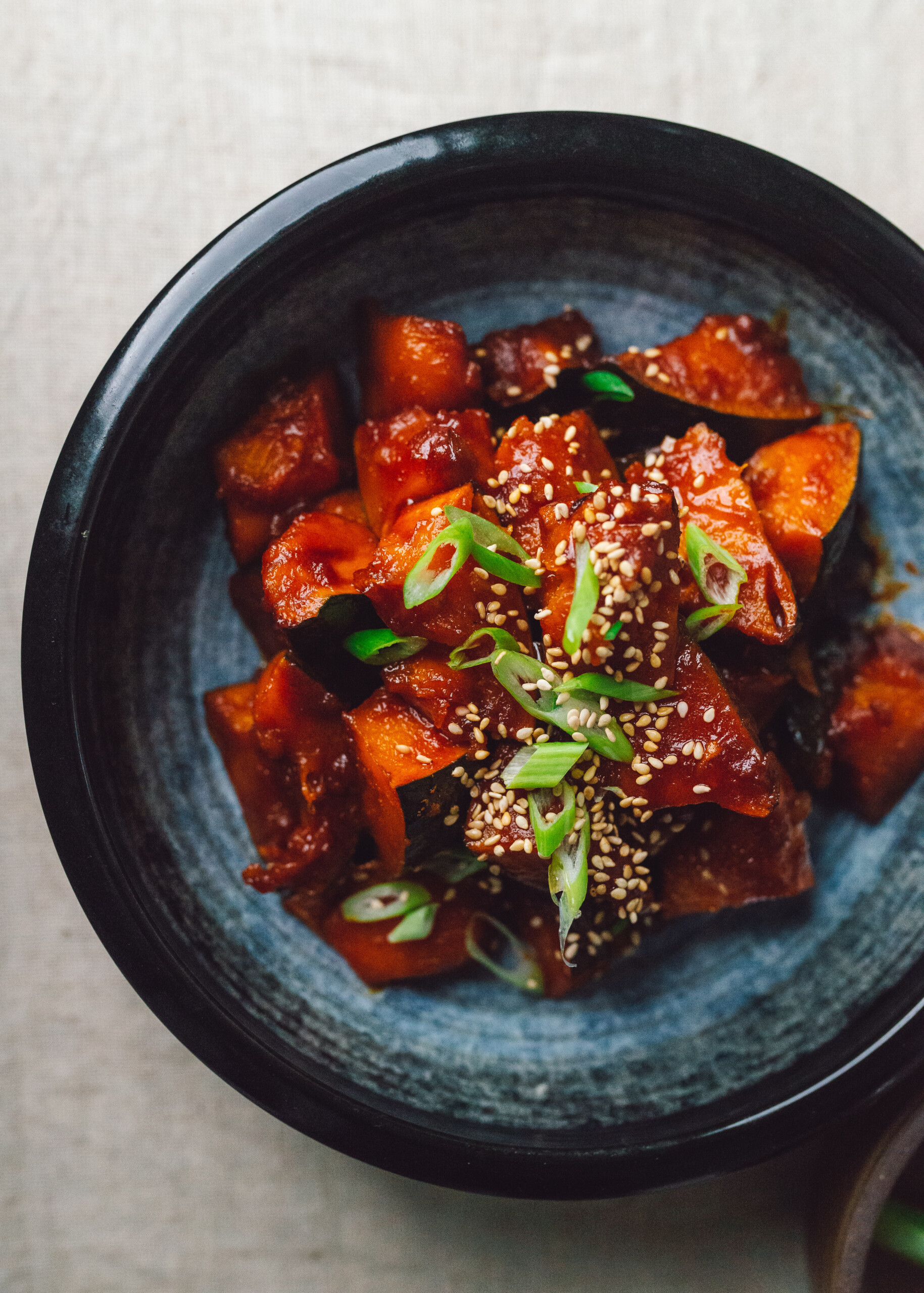
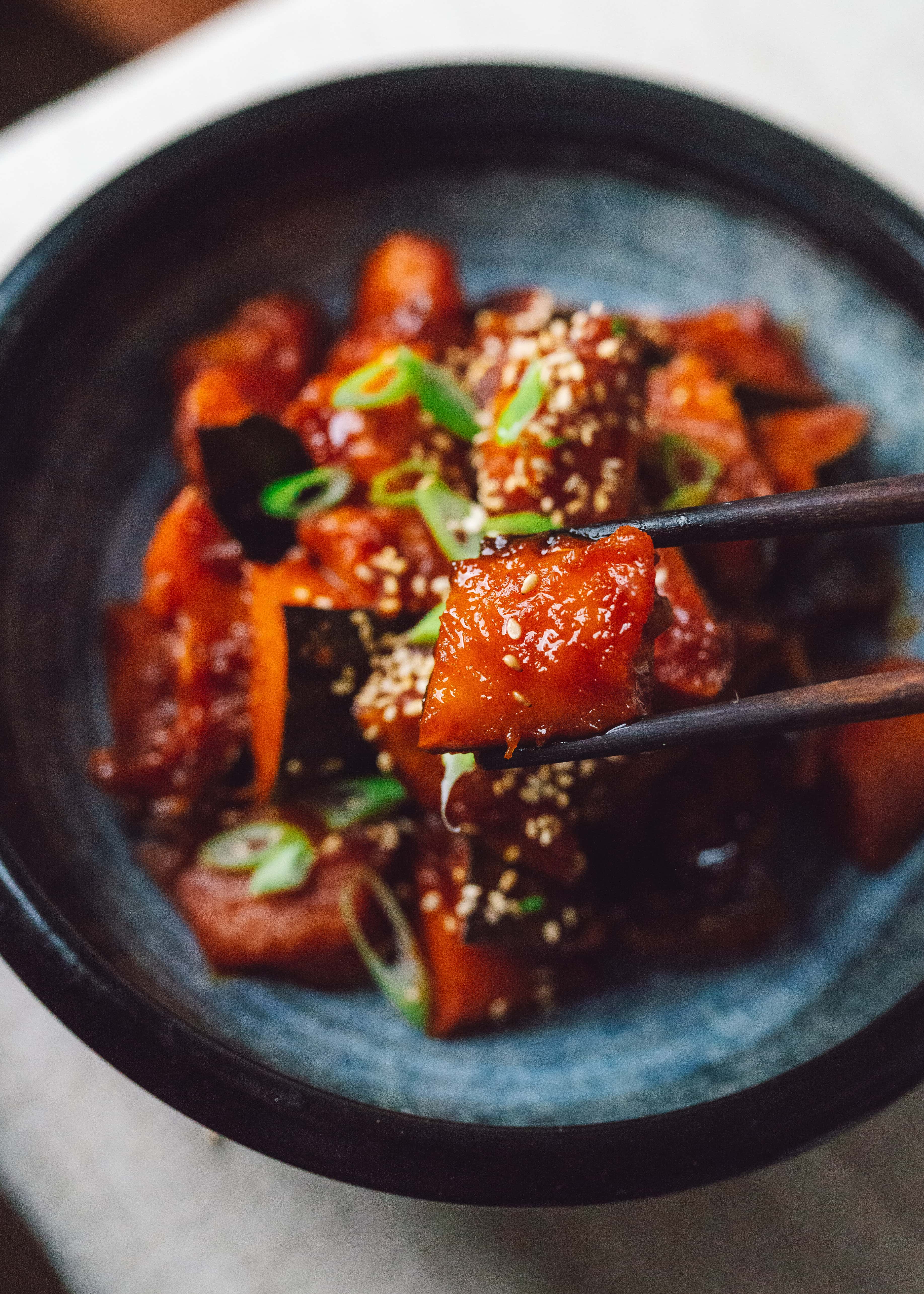
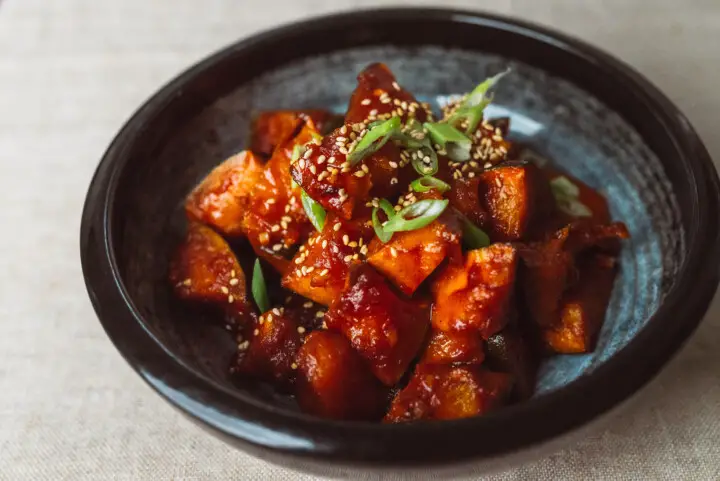
Frequently used in Japanese, Chinese, and Korean cuisine, kabocha squash has dark green skin and fine-textured flesh without any of the watery or stringy qualities of pumpkin. Similar to butternut, acorn, or red kuri, but with drier and sweeter flesh, kabocha’s starchiness actually reminds me more of a root vegetable like a yam or sweet potato. Its earthy, nutty flavor is similar to a roasted chestnut— in Chinese kabocha is actually called chestnut squash (banli nangua 板栗南瓜). Another name for it in southern China is bei bei gua 贝贝瓜 (could be translated baby squash, or literally, bae bae squash).
How to Cook Kabocha Squash
There are two methods for making this dish:
- Cut the raw squash into chunks, then braise. Cut the squash whole and remove the seeds and core, then cut into 2-inch chunks and braise directly in the pan on the stove-top. You will need to add about 2 cups liquid instead of ¼ cup.
- Roast the squash in the oven first, then cut. This is the more hands-off approach: you can let the squash cook fully in the oven so the braising step takes only a few minutes. It’s also much easier to de-seed and cut the squash into pieces after it’s roasted.
I prefer method 2 for this dish.
Step 1: Roast the squash.
Roast the kabocha squash. Preheat the oven to 425°F (220°C). Rinse the outside of the squash and cut it in half. Place both halves cut-side up in the oven, and roast for about 35 minutes, until the tip of a knife pierces through the interior easily. Remove the seeds with a spoon and discard; leave the peel on. Slice the squash into 1-inch U-shaped wedges, then cut into 2-inch chunks.
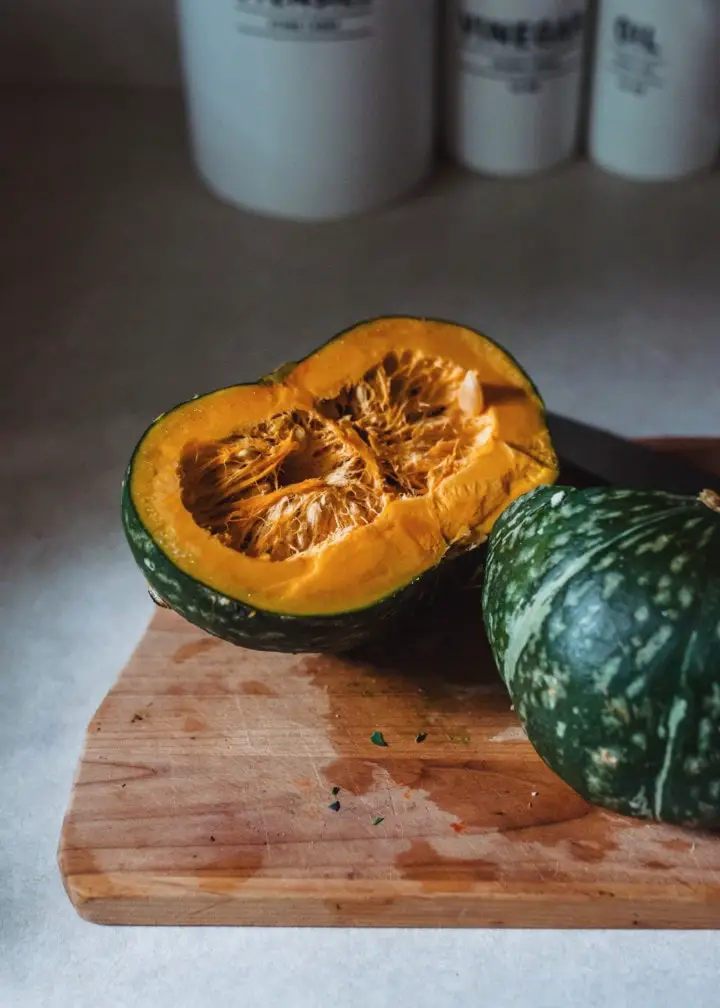
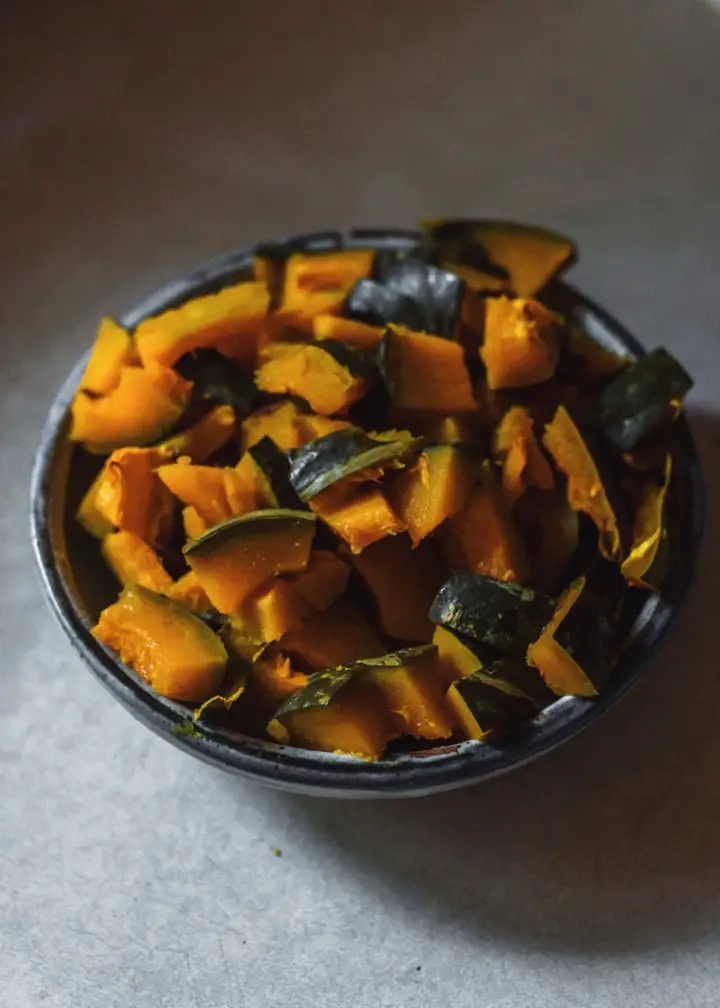
Step 2: Stir-fry the aromatics.
In a wok or large saucepan over medium heat, heat the olive oil until shimmering. Stir-fry the minced ginger and scallion whites until fragrant and the ginger is starting to color, about 2 minutes. Add the minced garlic and stir-fry for another 30 seconds.
Pour in the water, then add the sugar, soy sauce or tamari, and mirin. Stir until the sugar is dissolved and the liquid is starting to bubble. Add the rice wine vinegar and gochugaru flakes. Continue to cook for 2 more minutes until the liquid is reduced by a third and thickened.
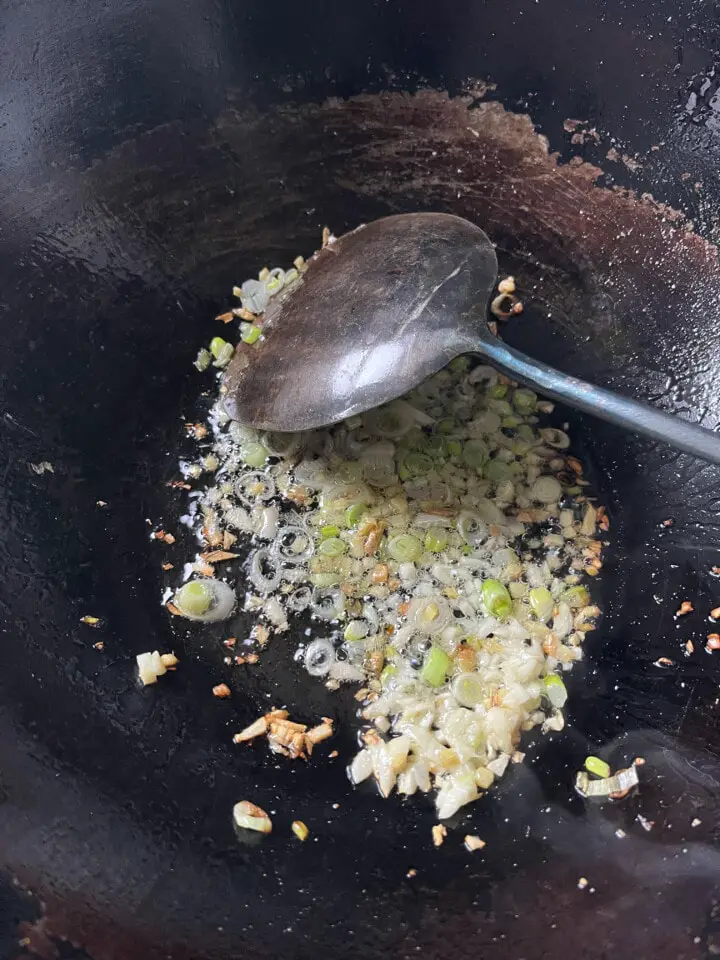
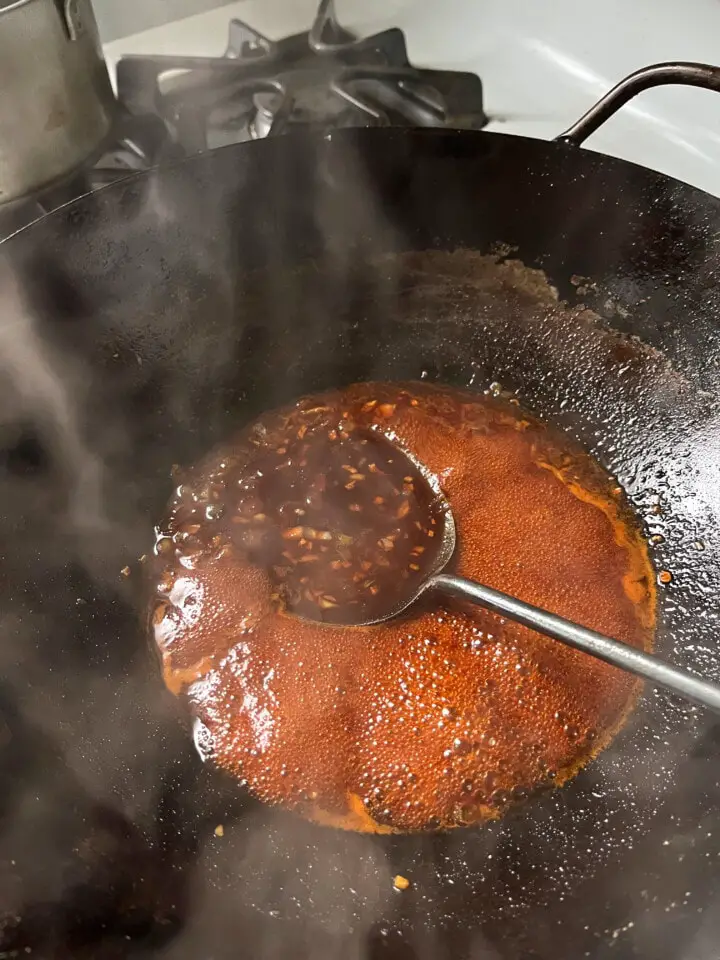
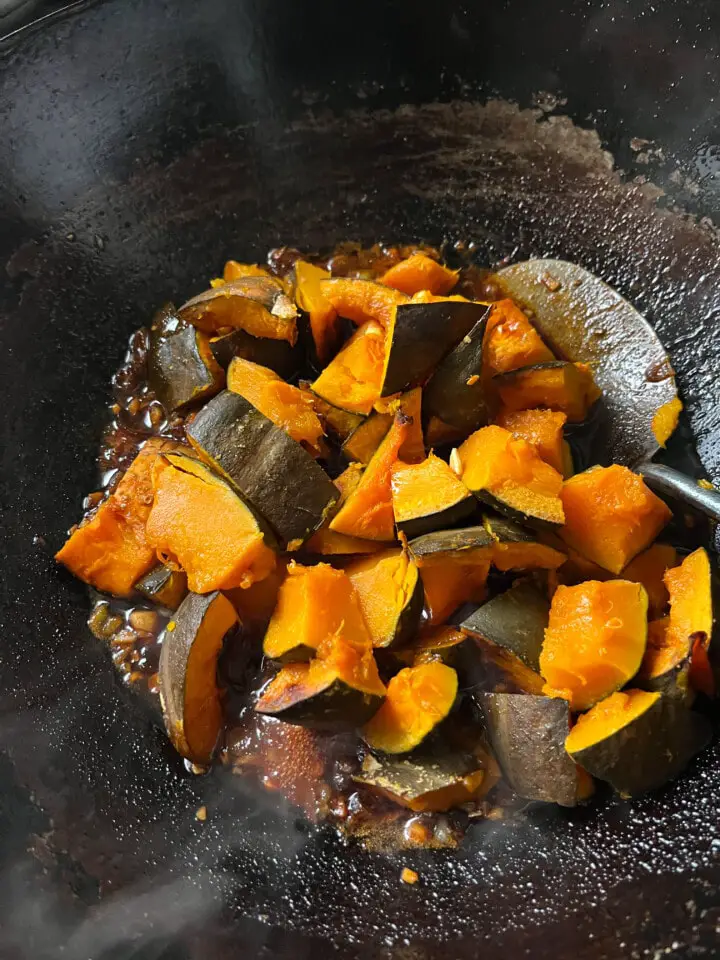
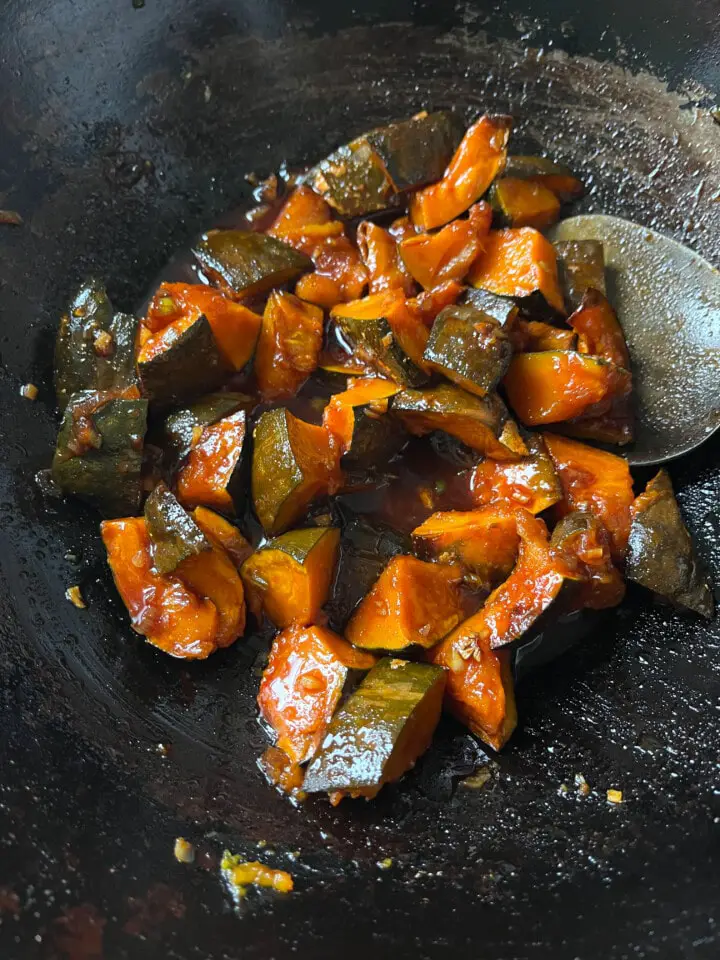
Step 3: Add the kabocha squash to the sauce.
Fold in the roasted kabocha squash pieces gently into the sauce until they are thoroughly coated. Simmer for 1 more minute, then remove from heat.
Serve!
Transfer to a serving dish along with any remaining glaze. Drizzle with the sesame oil and garnish with the thinly sliced scallion greens and toasted sesame seeds. Serve immediately.
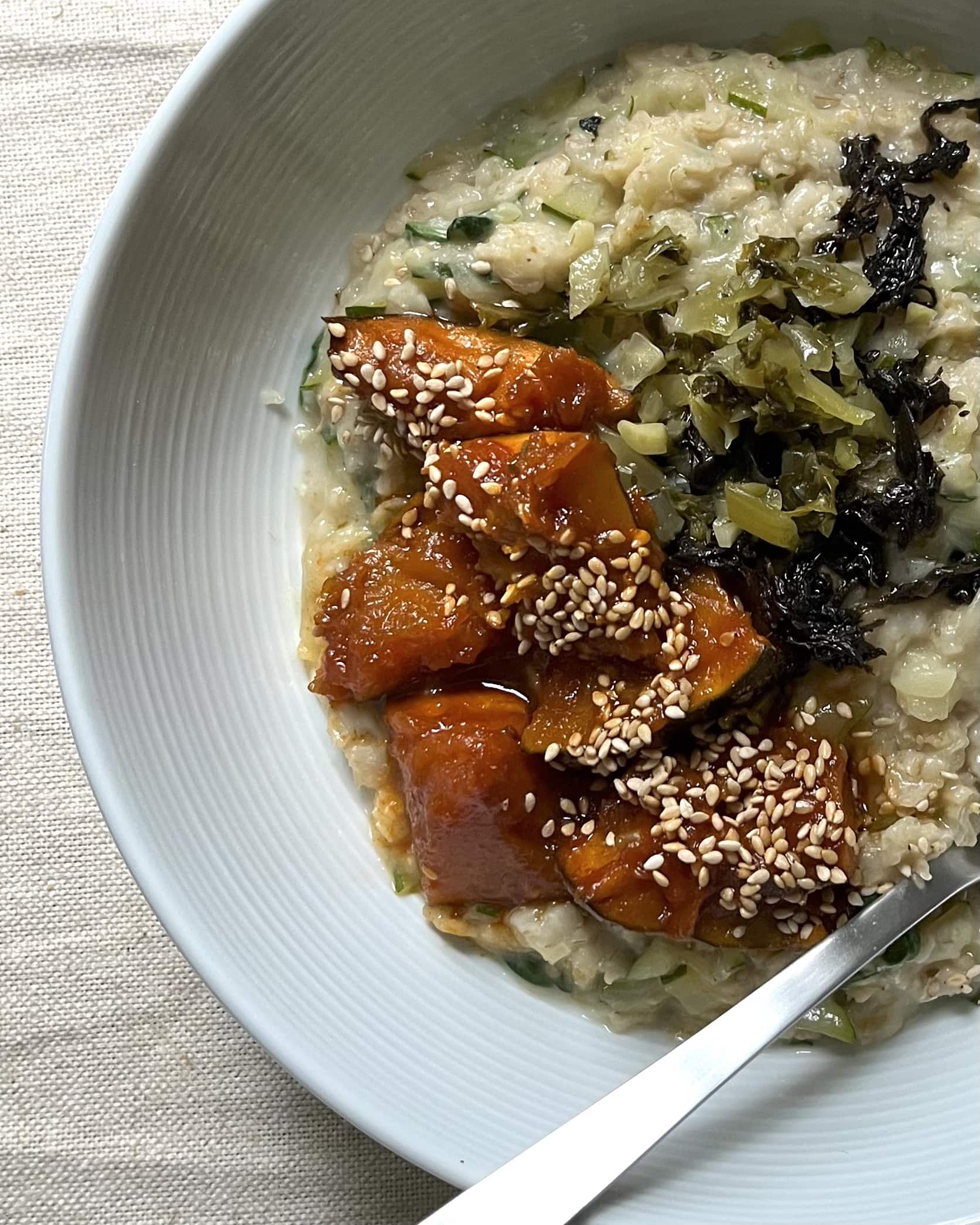
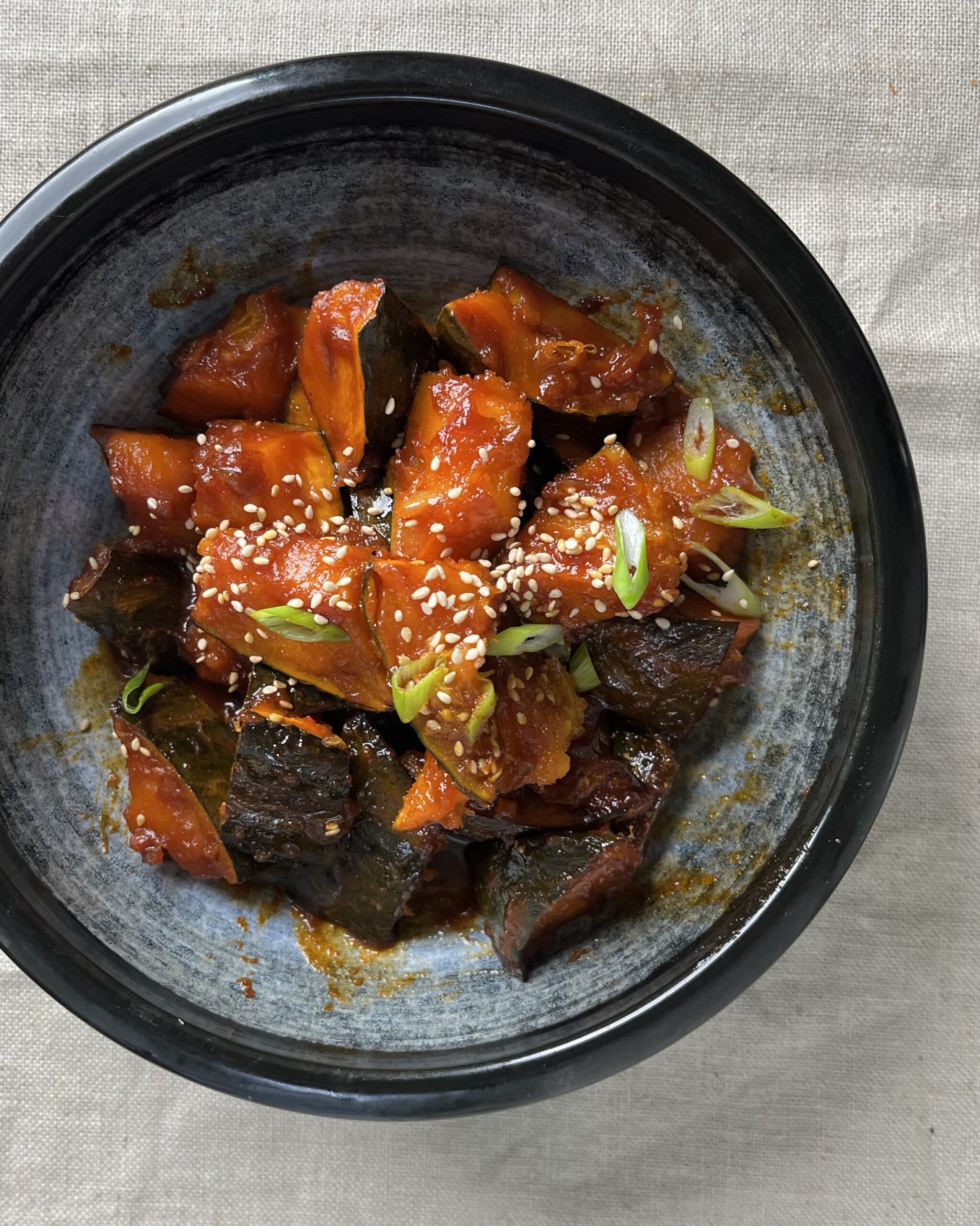
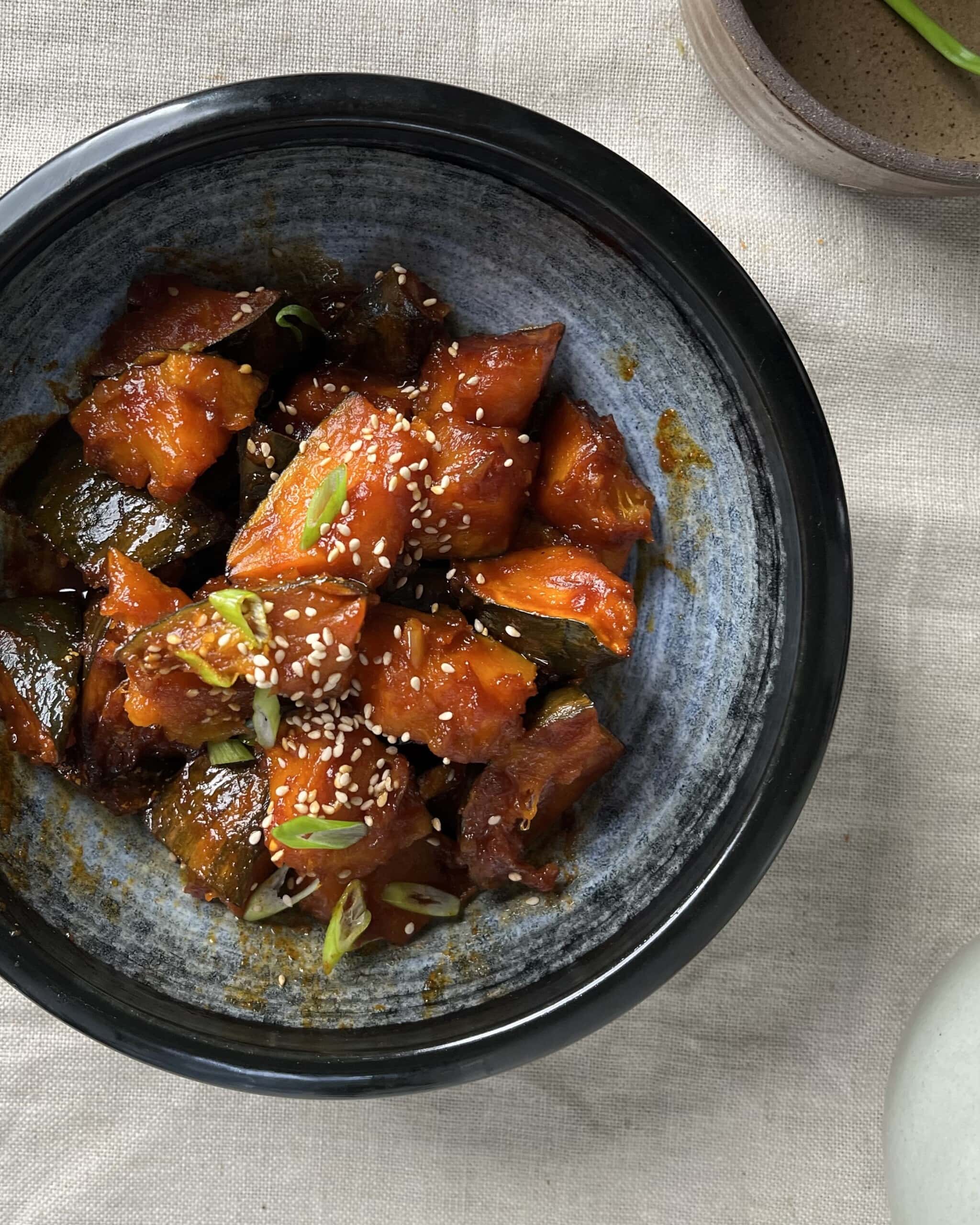
How to Store
Store any leftovers in a covered container in the refrigerator for 3 to 4 days. This dish can be enjoyed chilled as well.
I hope you enjoy this dish! It’s hearty and comforting and packed with umami— a dish that wonderfully showcases the natural sweetness and flavor of kabocha squash.
More Winter Squash Recipes:
- Pumpkin Chickpea Curry
- Roasted Butternut Squash Miso Mac N’ Cheese
- Oven-Baked Butternut Squash Fries
If you made this braised kabocha squash or any other recipe on the blog let me know how you liked it by leaving a comment and a rating below. Or tag me on Instagram @hannah.che, I love seeing your re-creations!
Follow me on Pinterest and save this recipe for later!
Print📖 Recipe
Simple Braised Kabocha Squash
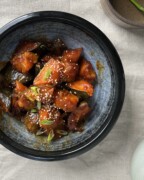
A simple yet satisfying Korean-inspired dish of kabocha squash, glazed in soy sauce, mirin, gochugaru, and sesame oil, with a touch of heat. Comforting and rich with flavor, this winter squash dish is also vegan and gluten-free.
- Prep Time: 15
- Cook Time: 45
- Total Time: 1 hour
- Yield: 4 1x
- Diet: Vegan
Ingredients
- 1 medium (900 g, 2 pounds) kabocha squash, about 5 cups (600g) roasted and chopped
- 1 tablespoon olive oil
- 1 tablespoon minced ginger
- 2 scallions, sliced thinly, white and green parts separate
- 2 tablespoons minced garlic
- ¼ cup (60ml) water
- ¼ cup (25g) brown sugar or coconut sugar
- ⅓ cup (80ml) low-sodium soy sauce or tamari
- ¼ cup mirin or rice wine
- 1 tablespoon clear rice vinegar
- 1 tablespoon gochugaru (Korean red chili powder; substitute with red chili flakes)
- 1 tablespoon toasted sesame oil
- Toasted sesame seeds, for garnish
Instructions
- Roast the kabocha squash. Preheat the oven to 425°F (220°C). Rinse the outside of the squash and cut it in half. Place both halves cut-side up in the oven, and roast for about 35 minutes, until the tip of a knife pierces through the interior easily. Remove the seeds with a spoon and discard; leave the peel on. Slice the squash into 1-inch U-shaped wedges, then cut into 2-inch chunks.
- Stir-fry the aromatics. In a wok or large saucepan over medium heat, heat the oil until shimmering. Stir-fry the ginger and scallion whites until fragrant and the ginger is starting to color, about 2 minutes. Add the garlic and stir-fry for another 30 seconds. Pour in the water, then add the sugar, soy sauce or tamari, and mirin. Stir until the sugar is dissolved and the liquid is starting to bubble. Add the rice wine vinegar and gochugaru chili powder. Continue to cook for 2 more minutes until the liquid is reduced by a third and thickened.
- Add the kabocha squash to the sauce. Fold in the roasted kabocha squash pieces gently into the sauce until they are thoroughly coated. Simmer for 1 more minute, then remove from heat.
- Serve. Transfer to a serving dish along with any remaining glaze. Drizzle with the sesame oil and garnish with the thinly sliced scallion greens and toasted sesame seeds. Serve immediately.
Store the leftovers in a covered container in the refrigerator for 3 to 4 days. This dish can be enjoyed chilled as well.
Notes
- To make this dish gluten-free, use tamari instead of soy sauce.
- The skin of the squash comes off easily after roasting. You can peel it before cutting into pieces, but since the skin is edible and usually tender, I prefer to leave it on. It’s also full of nutrients and lends a wonderful nutty flavor.
- If you would like to skip the roasting step and braise the squash directly over stove-top, peel and cut the squash into 2×1 inch pieces. Follow the steps as above, but use 2 cups of water instead of ¼ cup, and add the raw squash pieces immediately after adding the liquid. Cover and braise until the liquid reduces and the squash is tender enough to pierce with a fork, about 12-15 minutes.

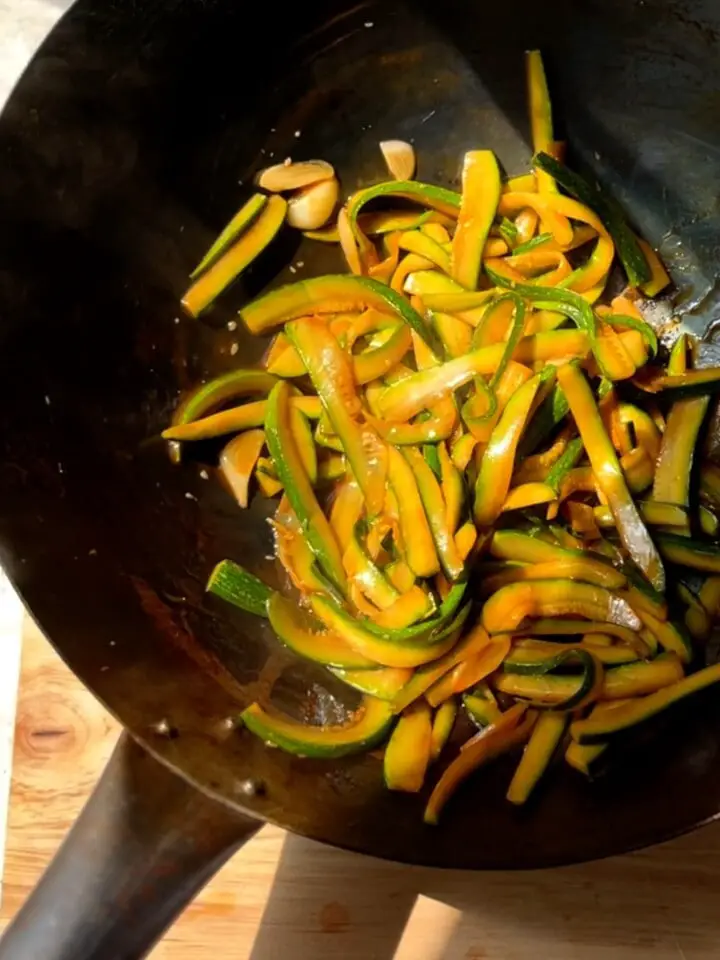
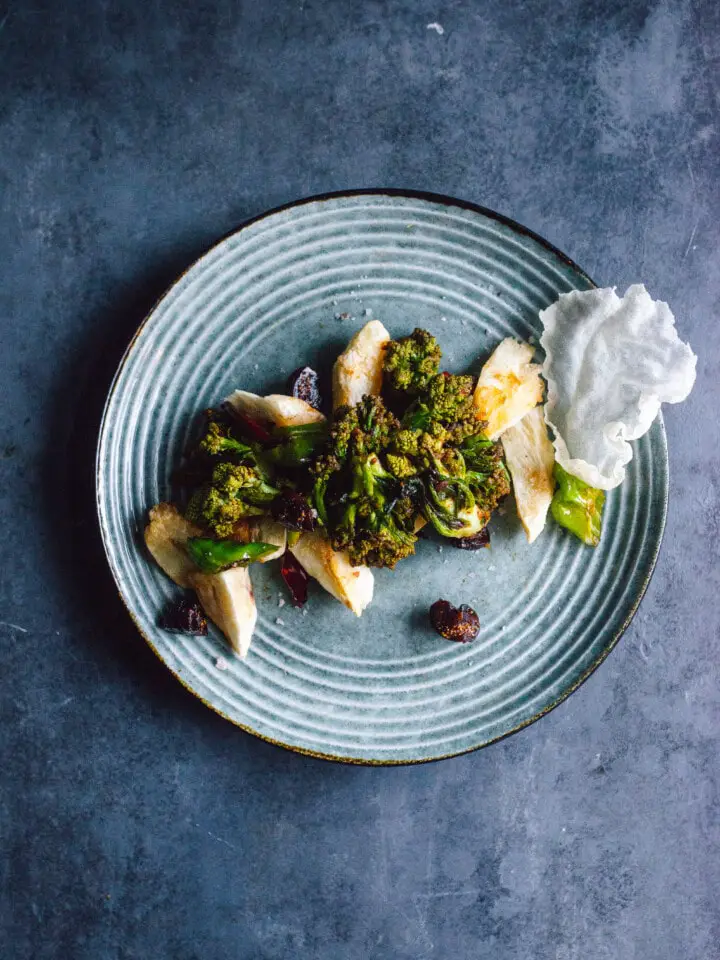
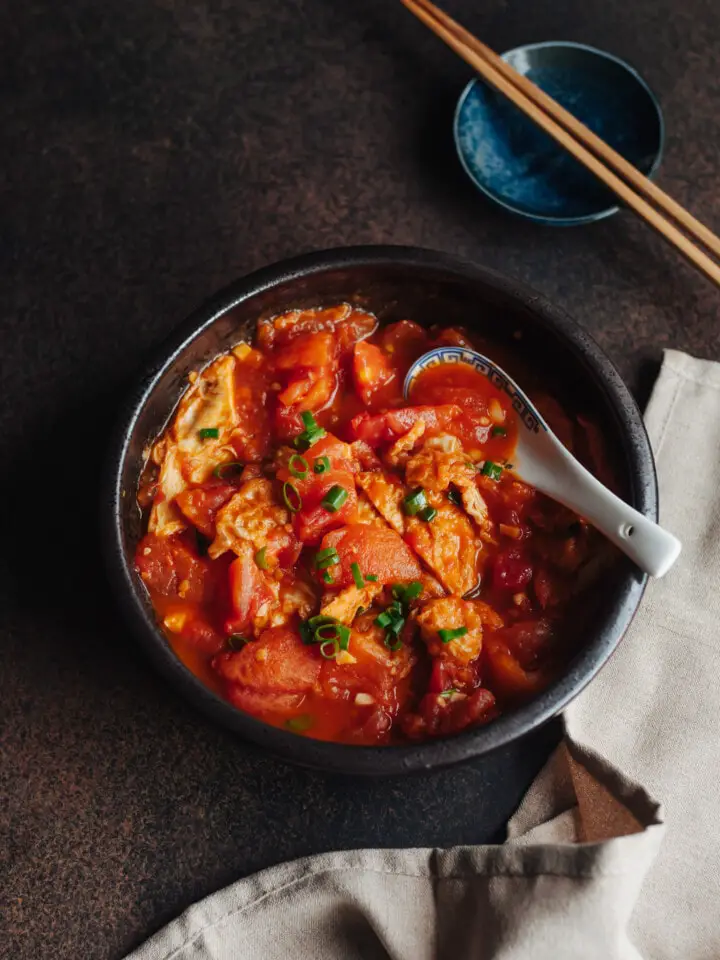
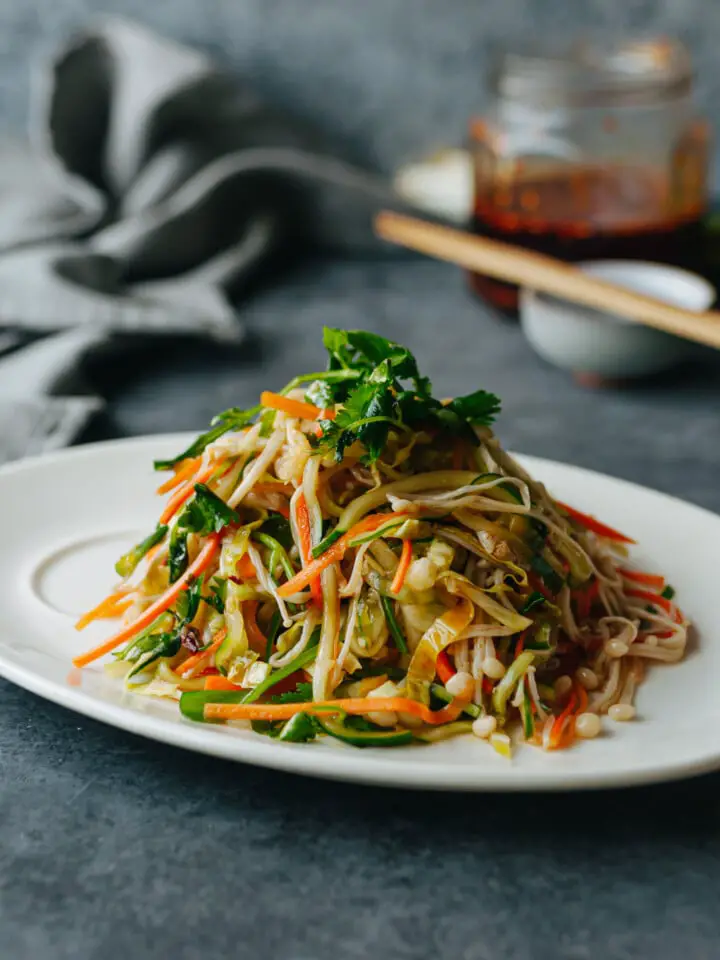
M says
This was amazing, but the recipe steps don’t say how to use the gochugaru. I made it as written without gochugaru and then served it with gochujang on the side.
Kaitlyn says
I was on the hunt for a easy and delicious kabocha recipe and this one is a winner! I can’t wait to try more of your recipes!
★★★★★
Jen says
Very simple and delicious recipe, would highly recommend! I can’t handle as much spice so I used about half of the gochugaru called for. I also chose to microwave the kabocha for a couple of minutes before cutting which made it much easier, then reduced the roasting time by 5-10 minutes.
★★★★★
Rachel Levy says
Followed the roasting instructions and then threw everything else in a jar to shake up. Put the sauce in a pan for a couple minutes and then added the squash. Super yummy!
★★★★★
Sp says
Amazing!
Catherine says
This recipe is amazing. The blend of flavors is wonderful. I also really like the method of roasting the squash first and then tossing it in the sauce. The only thing I would say is that for my palate, 1 tablespoon of gochugaru would have been far too far spicy. I used one teaspoon and it was plenty for me. Who knows – I may have purchased a very spicy brand (and I did go heavier on the ginger). However, I would still suggest adding a little gochugaru at a time to the sauce until it suits your personal taste. This is my first time to Hannah’s site and I am impressed. Hope to try some of her other recipes soon!